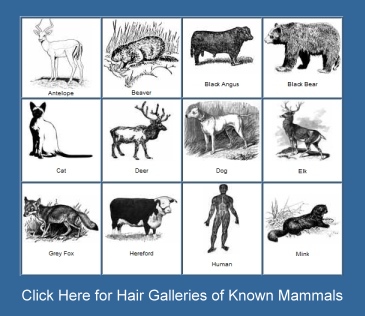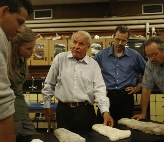| |
More
than a dozen hair/fiber samples were collected in the wild, in North America,
in
2008 (and so far in 2009), and
sent to the BFRO. Many have not yet been identified yet, but are likely
not primate hairs.
As with any set of hair/fiber samples collected over a given period by
bigfoot enthusiasts, most will eventually be identified as known mammals
or plant fibers, but some will probably be non-human primates -- the type
we are interested in.
The first step in analyzing hair/fiber samples is microscope analysis
-- not DNA analysis. DNA analysis is a time consuming, expensive process
that should only be directed at hairs that have been been vetted via microscopy
first.
Dr.
Henner Fahrenbach had been receiving, analyzing and vetting hair/fiber
samples for the BFRO for the past 12 years or so. He has graciously provided
a comparitive microscope slide for reference (included in the linked album
on the right). This sample from Fahrenbach was one of a few (among the
many submitted) that he believes may be from a non-human primate. His
conclusion in that regard considers a wide variety of factors, which will
be explained later.
Very good digital microscopes are becoming more affordable, so more people
will be able to acquire microscopy images than in the past. With that
in mind, it will be helpful for bigfooters (i.e. bigfoot research enthusiasts)
to become familiar with different types of mammal hairs.
Each
hair image in the BFRO hair gallery has its own commentary section, but
we have disabled those sections because the photo sharing site "Photobucket"
forces people to register before posting. If you are going to have to
register to comment on the images then you might as well register on the
BFRO's public forum and post your comments there.
We
would like to see comments from hair experts who can help identify the
sources of the various samples provided to us. Some of the hairs/fibers
from the 2008-09 collection have already been identified, but others have
not.
|
|

The hair samples linked above which were sent to the BFRO for examination
were mounted with permount fluid and coverslipped before being photographed
under a digital microscope.
The current hair examiner for the BFRO is a young scientist (Ph.D. in
Ecology from Princeton) hired by Adrian Erickson (British Columbia). The
digital microscope equipment she is using was provided by Wally Hersom
(California). Hersom and Erickson are currently the two major financiers
of independent bigfoot research projects.

|
| |
The articles linked below are at least a few years old by now, but
most of what they say is not out-of-date. The supreme authority
on this topic still seems to be a man named Doug Deedrick -- the
FBI's top hair guy at Quantico. A few of his articles are linked
below. Deedrick's articles will make you relatively knowledgeable
on the subject very quickly.
The next group of articles relate to the bigfoot-specific work of
Dr. Henner Fahrenbach. Fahrenbach closely followed the efforts analyze
purported bigfoot/yeti samples over the years. He has a unique perspective
on the subject of bigfoot hair analysis. Some of these articles/comments
below are more than ten years old, so some of the assertions may
be incorrect at this point in time, especially regarding avenues
of forensic inquiry that he concludes are "futile" (at
that time, way back in the 1990's).
The BFRO is hoping to receive more hair samples this year. If you
find hairs in the wild near any of the incident locations shown
on the Google Earth layer, please let us know. Please email us at
Contact@BFRO.net. We may ask you to send photos of the hairs, and
photos of what they were snagged on, etc., to help rule out possible
sources.
If you are a student or teacher at a university with equipment for
acquiring different types of microscopy images (especially scanning
electron microscope imagery), or equipment for DNA analysis, and
you are in a good position to encourage discrete involvement in
this type forensic inquiry, please contact us at Contact@BFRO.net |
|



























